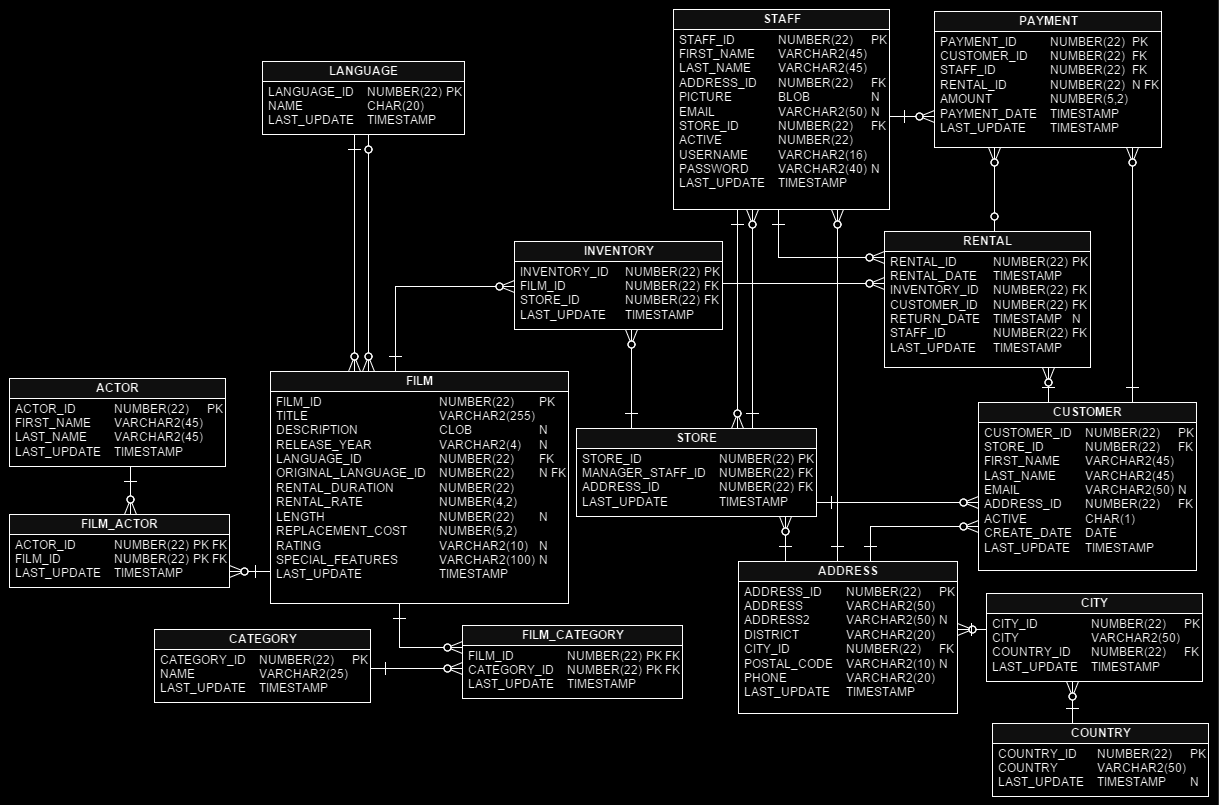To test my comprehension of SQL, I decided to find an
example database (DB) that had an interesting degree of complexity.
After some searching I found Sakila, a DB made by MySQL that is meant to
provide a standardised schema to study and work from.

Sakila is a well normalised model of a DVD rental store, featuring
things like films, actors, film-actor relationships, and a central
inventory table that connects films, stores and rentals.
To think of an interesting query, I started making simple read queries
using inner joins to get an idea of the tables and data I am working
with.
SELECT release_year,
title,
name,
description,
length,
first_name,
last_name
FROM film
JOIN film_category ON
film_category.film_id = film.film_id
JOIN category ON
category.category_id = film_category.category_id
JOIN film_actor ON
film_actor.film_id = film.film_id
JOIN actor ON
actor.actor_id = film_actor.actor_id;
The table produced is a little too large to publish on this page,
but if you wish to view the redacted version, you can see it
here
From this I decided that I wanted part of my query to draw from
the film descriptions, titles and actors as I felt it would enable me
to use wildcards in an interesting way and give me a chance to
concatenate columns.
Next I decided to look into the customer and rental tables, as that
would give me the opportunity to use the central inventory table to
make a more complex query.
SELECT first_name,
last_name,
country,
city,
address,
postal_code,
phone,
create_date,
email,
rental.rental_id,
rental_date,
amount,
payment_date
FROM country
JOIN city ON
city.country_id = country.country_id
JOIN address ON
address.city_id = city.city_id
JOIN customer ON
customer.address_id = address.address_id
JOIN rental ON
rental.customer_id = customer.customer_id
JOIN payment ON
payment.rental_id = rental.rental_id
ORDER BY first_name, last_name;
If you wish to view the redacted table, click
here
From this information, I decided to use the rental_date column as that
would allow me to use a BETWEEN operator on a date.
Here is the final query I came up with:
-- Customer, Adrian Clary, rented a film
-- between the 11th and 28th of July 2005
-- that included 'monkey' and 'womanizer'
-- in the description. He wants to know
-- the title of the film and the actors
-- that starred in it.
SELECT *
FROM (
SELECT title,
description,
CONCAT(
actor.first_name,
' ', actor.last_name
)
AS actor_name,
CONCAT(
customer.first_name,
' ', customer.last_name
)
AS customer_name,
rental.rental_date
FROM film
JOIN film_actor ON
film_actor.film_id = film.film_id
JOIN actor ON
actor.actor_id = film_actor.actor_id
JOIN inventory ON
inventory.film_id = film.film_id
JOIN rental ON
rental.inventory_id = inventory.inventory_id
JOIN customer ON
customer.customer_id = rental.customer_id
) AS query_for_adrian_c
WHERE description LIKE '%monkey%%womanizer%'
AND rental_date BETWEEN
'2005-07-11%' AND '2005-07-28%'
AND customer_name = 'Adrian Clary'
ORDER BY actor_name;
First I create a subquery, so that the concatenated customer and actor
names can be accessed in the new table created. As I am using MySQL,
I use the CONCAT() function to concatenate the first and last name of the
actors and customer respectively.
Each JOIN are inner joins that just enable each column to be
linked to their associated primary and foreign keys.
I use a LIKE operator in the WHERE clause and the % wildcard character
to search for a 'description' entry with 'monkey' and 'womanizer' anywhere
in it.
The BETWEEN operator is used to search for a date within the given range.
The % wildcard here is used to specify that the time portion of the
datetime entry is not necessary for the search.
To wrap up the where clause, we make sure we are searching for the
information associated with the correct customer (there is a surprising
amount of film titles with 'monkey' and 'womanizer' in the description
that were rented out between the 11th and 28th July). To do this, we
search for 'Adrian Clary' in the column that was aliased 'customer_name'.
Finally we order the aliased actor names alphabetically (ASC is the
default value of ORDER BY).
To view the table produced by this query, click
here